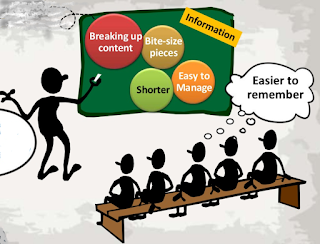Information processing model: Implications for teaching and learning
In
the last post I wrote about a very simplified version of how our brains process
information - what is forgotten; what is retained for further processing and
how long term memory is developed. Here I will revise some key points and
explain the teaching and learning implications for teachers and students.
As
I discussed, the working memory has limited capacity. Information stays here
for about 5-10 minutes (for kids) and 10-20minuts (for adults). The number of
items/chunks of information is between 2-5 (for kids) and between 5-9 (for
adults). This has a serious implications for teaching and information retention.
All teachers hope that each student will store the information for long term
use and in fact reproduce it in exams.
If
you are a school teacher or a student, you know that a period is between
20-30minutes. Because students can concentrate for only 20 minutes. This is
still long period for the brain to work on one activity, so teachers do different
activities in one period. Sometime is spent on verbal discussion, some writing,
and majority on doing something. This means that we pack our lessons in 15-20
minutes small chunks of information. You can observe there are two types of
chunking taking place: one is time wise and second is item wise. In other words
SHORTER IS BETTER and LESS IS MORE.
A
good lesson plan will have defined number of items or information. It is called
measurable outcomes or lesson objectives. If a lesson plan requires students to
learn the names and locations of 10 rivers in the world, that means it has more
items and can be problematic for the working memory to process. It is important
to keep the number of items in a lesson objective within the age-appropriate
capacity of information handling. This way more students will be able to
process the information and pass the information onto the long term memory. This
is LESS IS MORE.
Past
knowledge or experience already stored in the long term memory is very
important. At the beginning of the lesson the teacher can activate those
memories or neurons. So that a meaningful connection of information could be
developed to strengthen the neural connection.
As
indicated in the previous post, the working memory takes about 24 hours to work
and store the information. It is recommended for teachers to take tests after
24 hours have passed. A test immediately at the end of the lesson can be used
as a practice test but not for grading or assessment.
Personal
reflection time at the end of a lesson boosts the neurons involved in the
lesson. Teachers can provide a 3-minutes quiet time at the end of the lesson.
Students can be asked to close their eyes and think of the information they received.
It will provide more time to the working memory to concentrate and activate the
neuron connection to the long term memory. For students, I recommend to reflect and revise
information at night while on bed trying to sleep. This will help in
consolidating the information gained and improve neuron connections. It can
also help in transferring information to long-term memory during deep sleep (as
discussed in the previous post). This means, revising information immediately
before sleep can improve your long term storage.
When
the working memory perceives that an information does not make sense or is not
relevant, the information is forgotten easily. Long term storage can be
increased by just making sure that the information is meaningful or relevant to
the learners. This can be done through the following strategies.
Sometimes the information is only
relevant when it has to be reproduced in tests or exams. This is why the
importance of test scores are increased in our system.
Sometimes, there is no short term
relevancy of the information. The long terms relevancy of the information
cannot be envisioned. For example in mathematics students only use formulas to
solve problems given in the text book. In this case they use a formula to solve
problems correctly but not see how that formula is useful in life. In such
cases, practice can help strengthen the neural connection and thus a transfer
of information to the long term memory can take place. Teachers can also tell
students about how it can be relevant to their future professions.
Meaning could also be just personal
interest and curiosity. Some people are intensely motivated about a topic and
they spend hours reading and processing it. They do not quite until physically
tired. Motivation is an emotional response of our brain which is very powerful
for learning (will be discussed in a future post).
As has been seen, past experience
is utmost important. That’s why students should learn concepts from earlier on
and build on it. They should start with very simple information/knowledge and
move towards complex concepts. Teaching strategies suggest to move from the
known to the unknown or form the concrete to the abstract.
However
we must also change our perception of meaningfulness and relevancy. We must
understand that what was meaningful for us may not be meaningful for today’s
kids. That’s why it is so important that teachers keep with the up to date
knowledge and trends around the world –to make information meaningful for
students.
Since
emotions play a critical role in learning and it is argued that emotions take
over rational thinking. This has greater impact not only on learning but also
responding to different situations. I will discuss this phenomena in the next
post.


Comments
Post a Comment